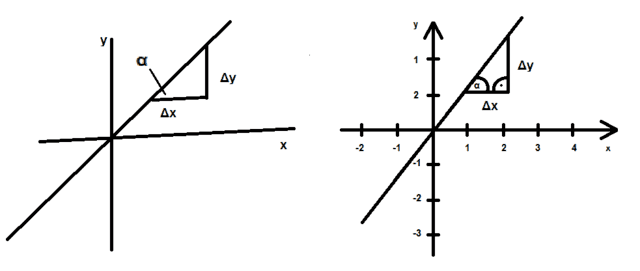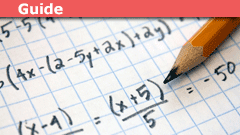10 Math Tips to Save Time and Avoid Mistakes
Exam situations are always situations of stress. It comes with our endeavor to be as good as possible together with our fear of failure. Some students handle these situations better than others. But there are some tricks I encountered over the years tutoring young students. I’m sure everybody has developed their own ways to get along with tests, so the following has to be a personal view of mine. It resulted from my experiences when I considered the mistakes my students had made. They are also of help on the daily business to do homework as fast as possible, save time, and avoid mistakes.
Table of Contents
Preparation
Preparation is more important than one might think, and I don’t mean the learning process here – this is self-evident. I mean the physic preparation for an exam or homework.
- Have some scrap papers at hand. You might want to do a calculation for control purposes, a long division, a quickly done graphic, or some plausibility checks which don’t belong to your final answer.
- Get your writing tools ready: pencil, eraser, sharpener, ruler, compass, or whatever is needed and allowed. Have some additional pencils and maybe colored ones, just in case.
- Don’t forget your calculator or book of formulas if you’re allowed to use them. Check the batteries.
Now you can begin. But before you dive into the first problem, get an overview of all questions, just a short impression of what they are about and whether they match your expectations. You don’t need to read them in detail here, but you should do a triage, i.e. sort them in mind from easy to difficult. Maybe you even mark them with A-B-C for this reason. And this rating should be an individual one: your own perspective and none in an objective sense or whatsoever.
Clock Management
- Don’t panic. I know this is sometimes easier said than done, but it is important. Panic of any kind rarely is helpful. And although different people have different methods to deal with it, your preparations can help here, e.g. you can sort your writing tools, so this manual process can be used to channel your emotions and distract you.
- Don’t think … for too long on the same problem! You can change your rating, and if it takes too long, upgrade the difficulty and tackle the next question. If you’ll have time left at the end, come back to those questions.
- This means as a general rule: the easiest questions first.
- If you’re stuck, you could easily invest the entire available time on one certain problem. However, you’re here as a gatherer, not a hunter. You want to gather points. And this means sometimes many small steps instead of a few big ones. So in case, your working flow is interrupted: switch to the next hurdle. If your passing play doesn’t work, you’ll have to run for the yards. Of course, a Hail Mary is more attractive than three runs for a new first down, but this doesn’t count here.
- In case you’re left with plenty of time and have solved even the hard problems, there is a risk that you correct right things wrong. To go over your solutions again can be useful, but normally tension has left your body and you start to make mistakes. So it might be the better choice to end here.
After play
This part may be the most difficult one. Yes, you might feel relieved because it is done, but chances are high that it still is haunting your thoughts. But done is done and you shouldn’t waste time on what cannot be changed anymore. I know this is easily said. But it is true, get used to it. It can be helpful to concentrate on new lessons instead. But the time will come when you receive your results. And what should it have been good for, if you cannot learn from mistakes. So although it is over, it is also necessary to reconsider it. It’s this balance, that makes the period after a test a bit difficult. So the best thing would be to deal with it the most analytical way possible. The task is clear: to learn from mistakes. To do so it is helpful to reconsider the wrong answers and eventually write a correction. Figure out where you have been mistaken. You should also check them against the list of tips and tricks below, which is meant as a guide on how to solve individual questions, resp. problems.
1o Tips and Tricks
1. Read it twice
Read the question in one step once: from start to end. This way you know what it is about. Maybe you’ll already get an idea, how to solve it. After that read it again for the second time. But this time use your scratch paper to extract the numerical information given and mark the quantity which is asked for by a question mark. Now you can tackle it: Huddle – Line Up – Start.
2. Claim, Conditions, and Dependencies
It is important to keep given conditions and assertions apart. I’ve seen them confused a lot of times. Even if the result might be incidentally correct, it will be difficult to impossible to read your answer. This will be bad not only for your readers but also for yourself if you want to check it for mistakes. Part of it is to keep track of the right direction. Sometimes you’ll need to start at the claim to get an idea. It is somehow running first backward before you know the right way to go forward. Do this on your scratch paper and don’t forget to reverse it again, when you leave the box, run and pass the ball. Typical examples for such a procedure are ##\varepsilon – \delta## proofs or limit calculations. Also, mark dependencies whenever it is helpful. For all ##\varepsilon## there is an ##N##should actually be better For all ##\varepsilon## there is an ##N_\varepsilon##or ##N(\varepsilon)## because the choice of ##N## depends on the choice of ##\varepsilon##. The same is true in physics: A velocity might be dependent on time, so ##v=v(t)##. Use ##v(t)##. It is at almost zero costs in terms of time, and it makes sure you don’t overlook internal dependencies, like inner derivatives. It is important because the same situation could as well be ##v=v(x(t),t)## with the position ##x=x(t)## at a certain time and an entirely different situation. Keeping track of those dependencies automatically helps to avoid mistakes.
3. Think or Write?
Write instead of think. It sounds silly at first glance and I remember some very gazing views. But it is true. Writing is several times faster than thinking. What I mean is of course not that you should stop thinking. What I mean is this:
How many yards does a car get, when I’m distracted by my mobile phone for 10 seconds at a speed of 70 mph?
So instead of trying to solve
$$ 70\, \frac{mi}{h} \cdot 10 s $$
by calculating with 3,600 seconds an hour and 1,760 yards a mile all in your mind on an imagined big quotient, write it down, the more steps the better, because it means less risk and is easier to check:
$$70 \,mph \cdot 10 \,s = \frac{70 \cdot 10}{1} \cdot \frac{mi\cdot s}{h} = 700 \cdot \frac{1,760\, yd \cdot s}{3,600 \cdot s}\\ = \frac{700\cdot 1,760}{3,600}\, yd = \frac{7 \cdot 1,760}{36} \,yd = \frac{7 \cdot 440}{9} \,yd = \frac{3,080}{9}\,yd\\ = 342.2 \,yd $$
This might be a bit over-the-top but it is still a lot, lot, faster than doing it in mind, unless you are a savant. And the only risk of mistakes here is by writing, not by the concept. It actually saves time, although it doesn’t appear so.
4. Units are your friends
As my example already has shown, keeping track of the units is important. It is an automatic control for free and therefore reduces the risk of mistakes. If you are asked about yards as in the example and you still have miles or even seconds in your final result, then something went wrong. Units are your friends. Use them all the time, even if you have to invent them: If a woodcutter chops four trees an hour, then write ##1 W \triangleq 4\cdot\frac{T}{h}##. It might look funny, and if also work occurs in the problem you should choose another letter, but it definitely helps you to keep track of what you’re doing. Remember the catastrophic failure of the Mars Climate Orbiter.
5. Fractions
There is a lot that can go wrong with fractions: minus signs get lost, primary and secondary fractions are confused, if either the nominator or the denominator or both are quotients themselves, or units miraculously change from one side to the other, division by a quotient results in the wrong multiplication, the distributive law is forgotten – so basically every possible mistake is twice as likely if it is part of a quotient. So there is only one real piece of advice: be careful and distinguish primary and secondary quotients by their length and position. Another misbehavior that seems to last forever is a notation like ##1\frac{1}{4}##. Personally, I almost hate it, because usually, if we leave out a sign, it will be a multiplication dot as in ##5\,m## which is ##5 \cdot m##, or ##2\pi## which is ##2\cdot \pi##. But when people write ##1 \frac{1}{4}## it is all of a sudden a plus which is dropped, since ##1\frac{1}{4}= 1+\frac{1}{4}=1.25\,##. Even worse is the horizontal expression: Is it ##1\,1/4 = \frac{5}{4}## or ##1\,1/4 = \frac{11}{4}\,##? And what does ##1\,\,1 / 2 + 2## mean?
So either use the decimal expression ##1.25 ## or even better than this, write ##\frac{5}{4}##.
6. Parentheses
Use parentheses and if in doubt, use them. Sometimes this will result in quite a few nested parentheses but the solution to this is not to omit them but to use different ones: ##\{\; [\; (\;)\;]\;\}\;##. The most common mistakes are sign errors like
$$ – (1+ x) = -1 + x $$
and lost factors by disrespecting the distributive law like
$$ – 2 \cdot (1+ x) = -2 – x $$
Needless to say that these are completely unnecessary. But without parentheses, things are even worse.
7. Accuracy
A common question is: how many digits should I use? Well, it obviously doesn’t make sense to answer a question like:
How long is the diagonal of a room which is ##4.9 \,yd## long and ##8.7\, yd## wide?
by
$$9,9849887330932927798322882923393\, yd$$
just because the calculator says so. However, the problem with precision starts normally earlier than at the final value. What to do in between? A golden rule is to calculate as accurately as possible and only adjust the answers to the questions, whether in between or at the end. If we calculated instead with ##5\;yd## and ##9\;yd## in the example above, we would give as an answer ##10.3 \;yd## whereas the rounded answer would have been ##10 \;yd##. This might be a small difference, but it shows the problem: calculation errors pile up, so this rule makes sense: calculate correct, answer meaningful. This means roughly to use as many digits as the input values or measurements have.
Another source for precision problems is ##\pi##. Calculating with ##3.14## might not be sufficient, so the use of ##\pi \approx 3.14159265359## might be justified, but within an answer, it is probably not. Mathematicians usually keep those values as they are: ##\pi \, , \,\sqrt{2}\, , \,e## and leave it to others to put in the values they need. In this sense ##2\pi## has to be preferred over ##6.28##.
8. Inequalities
First of all: Don’t forget to turn the sign if you multiply by a negative number and consider both cases, in case you multiply by a variable which could be negative!
$$2 < n \text{ leads to } -2 > -n $$
and
$$\frac{2}{x} < 4 \text{ means } \frac{1}{2} < x \text{ or } \frac{1}{2} > x$$
The general treatment of inequalities depends heavily on the purpose they are used for. If we want to estimate the maximal run time or space an algorithm needs in a worst case scenario, or if we want to determine the error margin of a numerical solution of a differential equation, then we will certainly try to calculate these quantities as accurate as possible. This means the closest inequalities that are possible have to be taken: ##M=0.01## for ##\frac{1}{n^2}<M## with ##n > 10##. But far more often these narrow margins aren’t needed. If we have to proof a typical limit problem like
$$\lim_{n \to \infty} \frac{n+1}{1-2n}= -\frac{1}{2}$$
we’ll have to show, that for every ##\varepsilon > 0## (any arbitrary small given(!) margin) we can find a natural number ##N(\varepsilon)## such that all following terms of the sequence, that is all ##\frac{n+1}{1-2n}## with ##n > N(\varepsilon)## are closer to the limit ##-\frac{1}{2}## than the given margin. This is the entire idea, and it doesn’t play a role whether we chose ##N(\varepsilon)## as small as possible or not. There is no need here for especially narrow margins. So we can be generous and write
$$\left| \frac{n+1}{1-2n} – (-\frac{1}{2})\right| \stackrel{(n\geq 1)}{=} \frac{3}{4n-2} \stackrel{(n \geq 3)}{<} \frac{3}{3n} = \frac{1}{n} \stackrel{(n \geq \frac{2}{\varepsilon})}{<} \varepsilon $$
and we can simply chose ##N(\varepsilon) = \max\{3,\frac{2}{\varepsilon}\}\,##. Don’t even try to find a smaller value for ##N(\varepsilon)##. It takes more time, bears the risk of more errors and hasn’t the least advantage over a greater value.
9. Guesswork
- Don’t conclude or guess on assumptions.
- Don’t make hidden assumptions.
Both of these mistakes sometimes creep into proof or calculation. For e.g. in my previous example, when an inequality is multiplied by an unknown value, and you are tempted to consider it as a positive quantity, simply because you don’t consider the other possibility. Or a division without checking if the divisor is zero or not. And often there are even more subtle ways for hidden assumptions to enter your calculations at certain points. Take nothing for granted unless it is listed in the question. Also, fast conclusions based on intuition rather than facts can be a honey trap. I remember that I tutored an eighth-grader, whose method it was to check her answer by looking into my face instead of thinking herself, whether she was right or wrong. It is a quite smart idea. Unfortunately, I knew this and looked accordingly and during a test, there wasn’t someone to control. So lookout for the hidden things!
10. Plausibility Check
At the end of each calculation, there should be a short consideration, whether the achieved result makes sense or not. Are the units correct? Are the quantities within the expected range? Short: Is the result plausible?
If you started with lightyears, it is very unlikely that your result would be in millimeters. If you’re asked for the volume of a space, something cubed should have occurred in your answer. In earlier – pre-calculator times – students had to use slide rules or tables. They gave some digits as a result and a calculation of which quantities had to be used, in terms of significant digits and the position of the decimal point had been mandatory. Times might have changed, the reason to check amounts, numbers, and units hasn’t.
Appendix
The discussion of this article has revealed another important hint which I like to include and give an example, how to use it.
11. When in doubt, draw it out!
Most people (three out of four) are visually driven, i.e. they grasp an idea faster by visual input in contrast to acoustical input. So whenever possible, it can help a lot to sketch a given problem. If you’re well prepared, then you have some paper at hand to do it. Try to include all given information, but only be as accurate as necessary. E.g. I know that straights are given by an equation ##y=mx+b## and that the slope ##m## is a quotient. But was it ##m =\frac{\Delta y}{\Delta x}## or was it ## m =\frac{\Delta x}{\Delta y}\,##? One way to choose it right is to remember that units are your friends. So for the units we have ##[y]=[m]\cdot [x] + [b]## which shows, that the ##x-##part of ##m## has to be in the denominator in order to get the correct units: ##[y]= \frac{[y]}{[x]}\cdot [x]## and therefore ##m =\frac{\Delta y}{\Delta x}## has to be the correct one. Another possibility is to sketch it with a few lines. The following picture shows two ways, how this could be done:

Now guess what took me longer to draw, the left or the right one? If we have a question about certain numbers, and we want to check their plausibility, then the right one might be of greater use. Here, however, we spoke about to illustrate the slope ##m= \tan \alpha##, and in this case, the left one is sufficient. There is no extra award for exact scales, arrows, or similar, only costs in terms of time. Therefore be as accurate as necessary, but do not paint a van Gogh if a Miró will do.



Leave a Reply
Want to join the discussion?Feel free to contribute!